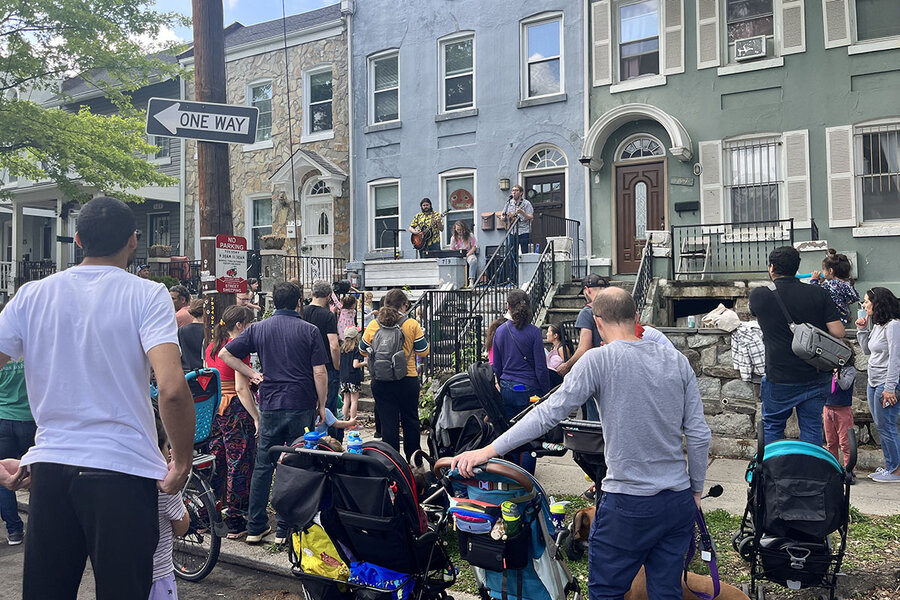Won’t you be my neighbor? How porch culture fights loneliness.
Loading...
| Washington
Karen Goddard calls herself a “professional porch sitter,” part of her attempt to make neighborliness popular again.
Ms. Goddard, who moved to Key West from New Hampshire two years ago, first came across the concept after reading an article about a self-proclaimed professional porch sitter. “It was all tongue-in-cheek. It was just something made up,” she says. “But it was a great concept.”
Why We Wrote This
A story focused onWhy do some people view a doorbell ringing as a threat? Meet the Americans embracing porch culture and trying to keep a sense of neighborliness and fellow feeling alive in a society with an epidemic of loneliness.
The point, Ms. Goddard says, is to meet on front porches without agendas, minutes, or formality – “just meeting and conversation.”
This week, the U.S. surgeon general declared an epidemic of loneliness and isolation, saying that 1 in 2 adults reported experiencing loneliness even before the pandemic. At a time when neighborliness is decreasing and Americans are growing further apart, some, like Ms. Goddard, are intentionally building relationships within their communities. Central to a culture of neighborliness, many say, are front porches.
“Front porch culture is just friendliness. It’s community, it’s interaction. It is wanting to have real community in the true sense of the word with neighbors and friends or potential friends,” says Campbell McCool, founder of a Mississippi development that centers community life. “It’s an analog lifestyle in a digital world.”
Lida and Mark Simpson sit on the steps of their porch with friends while the blues rock band Red Medicine plays in a yard across the street. People crowd all four corners of the intersection, dancing and chatting. It’s PorchFest in Petworth, a neighborhood of Washington, D.C. Some 100 performers will play on porches and yards throughout the day. A new group of people walks up, searching for space with a view of the band. “Sit, sit,” says Ms. Simpson with a big smile, gesturing toward the wall at the edge of the yard.
The Simpsons, who have a 4-year-old and a 6-year-old, chose Petworth because it’s walkable, close to restaurants and playgrounds and public transit, and still has a neighborhood feeling. When they first moved in eight years ago, Ms. Simpson says she hoped for an active front porch culture. But it didn’t quite coalesce until people began socializing from their yards in 2020. Happily, says Ms. Simpson, “porch and stoop culture restarted during the pandemic, and it’s stayed around.”
This week, the U.S. surgeon general declared an epidemic of loneliness and isolation, saying that 1 in 2 adults reported experiencing loneliness even before the pandemic. At a time when neighborliness is decreasing and Americans are growing further apart, some, like the Simpsons, are intentionally building relationships within their communities. And events like porch fests are growing in popularity. Central to a culture of neighborliness, many say, are front porches.
Why We Wrote This
A story focused onWhy do some people view a doorbell ringing as a threat? Meet the Americans embracing porch culture and trying to keep a sense of neighborliness and fellow feeling alive in a society with an epidemic of loneliness.
“Front porch culture is just friendliness. It’s community, it’s interaction. It is wanting to have real community in the true sense of the word with neighbors and friends or potential friends. It’s an analog lifestyle in a digital world,” says Campbell McCool, founder of a Mississippi development that centers community life.
It’s also in direct opposition to the kinds of tragedies that have struck urban, suburban, and rural communities around the country over the past few weeks. On April 13, 16-year-old Ralph Yarl was shot after knocking on the wrong door to pick up his siblings in Kansas City, Missouri. In upstate New York, 20-year-old Kaylin Gillis was shot and killed after the car she was in drove down the wrong driveway. And this weekend, a man in Texas killed five people, including one child, after he was asked to stop shooting in his yard because a baby was sleeping.
“As it has built for decades, the epidemic of loneliness and isolation has fueled other problems that are killing us and threaten to rip our country apart,” wrote Surgeon General Vivek Murthy in The New York Times on April 30, announcing a framework to rebuild community. “Rebuilding social connection must be a top public health priority for our nation. It will require reorienting ourselves, our communities, and our institutions to prioritize human connection and healthy relationships.”
A front porch is a liminal space, says Michael Dolan, a writer and editor in Washington. “It’s the outside of the inside and the inside of the outside, so people feel safe being on their porch because they are in their place and yet they are in the world,” he says.
“When people who have [porches and stoops] don’t use them, they’re missing out on the opportunity to interact with the environment,” says Mr. Dolan. “And the environment includes humans and includes passersby, includes somebody coming up to ask directions, includes somebody coming by to say hello.”
The type of neighborliness embodied by Mister Rogers is no longer the norm. Over half of Americans say they only know some of their neighbors. Although Americans living in rural areas are more likely to know their neighbors than Americans living in suburban or urban communities, people in the countryside are slightly less likely to interact with one another. Even in urban and suburban neighborhoods, neighborly exchanges are rare. Over half of Americans who say they know some of their neighbors say they never get together socially, according to a Pew study from 2019.
It takes curious and open people to build the kind of community that has block parties, borrows ingredients, and watches each other’s kids, but social spaces like front yards and porches are important too, says Mr. McCool. “A front porch is central to the whole personality of a neighborhood,” he says.
And at Plein Air in Mississippi, a development inspired by the new urbanism movement that promotes walkable and mixed-use communities, the only architectural requirement is that each house have a front porch.
History of the American front porch
Historically, Mr. McCool says, three things sped the decline of the front porch in suburbia in the 1950s: air conditioning, television, and the car. Air conditioning and TV coaxed people indoors. Cars meant more people lived further apart from each other.
When sociologists began studying differences between residents in neighborhoods with and without porches, they found that in the latter there was little to no interaction. People drove straight into their garages, and private backyard decks grew in popularity.
“A lot of people don’t realize that the social nature of the porch in America was imported with enslavement,” says Mr. Dolan, author of “The American Porch: An Informal History of an Informal Place.”
West Africans were kidnapped and brought first to Brazil and then to the Caribbean. There, enslavers directed them to build their own houses, which had porches where people could socialize out of the sun, says Mr. Dolan. That aspect of Indigenous African architecture spread throughout the New World. When French colonizers moved to New Orleans, the housing styles of West Africa were imported into Southern culture and eventually spread beyond Louisiana.
Today, polls show that older Americans are more likely to have neighborly connections. Just 4% of Americans over 65 say they don’t know any of their neighbors, compared with 23% of adults under 30. Older, white, and wealthy Americans are all more likely to say they trust their neighbors than Americans of color and those who are younger and less wealthy.
“Professional porch sitter”
Karen Goddard, who prefers porches to private decks, calls herself a “professional porch sitter” in her attempt to make neighborliness popular again.
Ms. Goddard, who moved to Key West from New Hampshire two years ago, first came across the concept after reading about a self-proclaimed professional porch sitter. “It was all tongue-in-cheek. It was just something made up,” she says. “But it was a great concept.”
The point, Ms. Goddard says, is to meet on front porches without agendas, minutes, or formality – “just meeting and conversation.”
It resonated with Ms. Goddard as something she was already doing. “My friends in my neighborhood in New Hampshire knew that they could come to my house any Friday night and hang out on the porch,” she says.
And, when Ms. Goddard sold her home in New Hampshire, her friends joked that the buyer should be informed that the house came with friends.
In an age of preoccupation with productivity, Ms. Goddard embraces the humor behind her chosen “profession.” It’s a label for, well, doing nothing. She and her husband had a joke: Ms. Goddard would sit on her porch, and occasionally her husband would poke his head out and say, “You’re doing a very good job, honey.”
Jokes aside, Ms. Goddard’s main reason for porch sitting is simple: “I like to smile and make eye contact and say ‘hello’ if possible, because I just think that’s important for human connection and for neighbors.”
The porch has always been a place of social interaction, says Mr. Dolan. That’s been his experience for the four decades he’s lived in the Palisades neighborhood of Washington, where he says neighborliness shines.
The rise of technology as an intermediary between people is unsettling, says Mr. Dolan. It makes its way onto the porch in the form of Ring Cameras, to which he’s opposed. “I like to answer my door and say hello to the people who come to my house,” he says.
“[One gains] the feeling of trust in the neighborly compact, the ability to rely on one’s neighbors and call one’s neighbors,” says Mr. Dolan. “Or even if your neighbors bother you, ... you tolerate them because they’re neighbors. So it’s a sense of place that reinforces your feeling of being part of something.”
The Simpsons in Petworth say they get together with neighbors throughout the year. The neighborhood has several active email lists, and neighbors swap tools, like the Simpsons’ hedge trimmer.
Despite the overcast sky, PorchFest is packed. Young children have no reservations dancing to music, playing with each other, and exploring neighbors’ yards. A crowd of kids gathers in front of one porch where a band plays “Heads, Shoulders, Knees, and Toes,” increasing the tempo with each refrain. The pack of 3-foot-tall children ecstatically dances to the song, giggling and trying to keep up, while bubbles float above their heads. As the band keeps playing, parents and teenagers join in.










